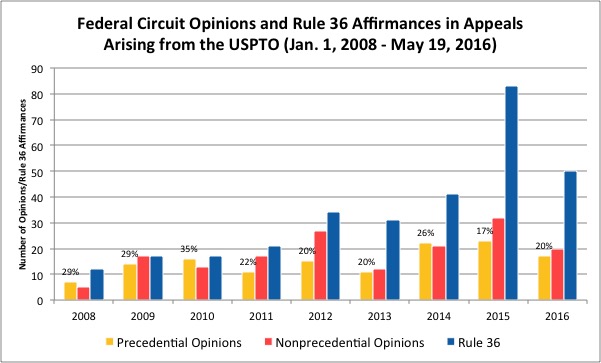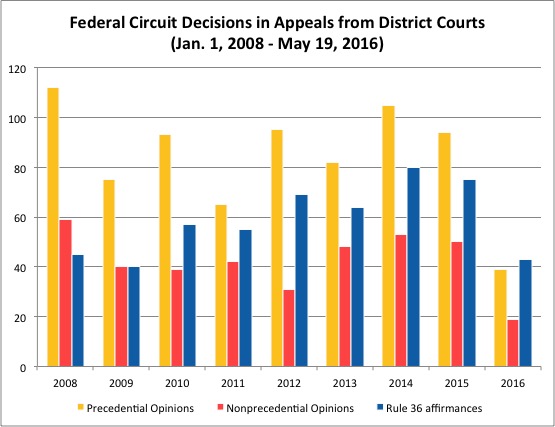By Jason Rantanen
A few months ago, I wrote that the Federal Circuit is now receiving more appeals arising from the Patent and Trademark Office than the District Courts. As of the end of May, that trend is still holding strong.
This influx of appeals raises the question of how the Federal Circuit will manage its expanded docket. One possibility is that the court will make greater use of Rule 36 summary affirmances in appeals where the panel votes to affirm.
To assess whether this is already happening, my research assistants collected and coded information about all decisions in appeals arising from the PTO and district courts that were posted to the Federal Circuit’s “opinions and orders” page since 2008. (To my knowledge, this represents the full set of opinions and Rule 36 summary affirmances, but if anyone has contrary information I’d be very interested in hearing it.) Orders (not all of which are posted to the website) are not included in the below graphs.
The first graph distinguishes between Federal Circuit opinions, both precedential and nonprecedential, and Rule 36 summary affirmances. The orange bars represent numbers of opinions each year and the blue bars represent numbers of Rule 36 summary affirmances. The percentages reflect the percentage of Rule 36 summary affirmances.
I see two takeaways from this graph. One is that the use of Rule 36 summary affirmances is indeed rising, both in absolute numbers and as a percentage of dispositions. During 2015 and so far in 2016, the Federal Circuit has resolved more appeals arising from the PTO through Rule 36 summary affirmances than with an opinion.
But the court can hardly be accused of slacking: at the same time that Rule 36 summary affirmances are going up, the court is also issuing more opinions in appeals arising from the PTO than ever before. Last year, the court issued almost 60 opinions in appeals arising from the PTO and this year it is poised to exceed that by a substantial margin.
A similar trend appears from looking at precedential and nonprecedential opinions separately. The following figure depicts numbers of precedential opinions (yellow), nonprecedential opinions (red), and Rule 36 affirmances (blue). The rate at which the court is issuing both precedential and nonprecedential opinions is climbing, with the court issuing only a few less precedential opinions in the first five-and-a-half months of 2016 than all of last year. The percentages here reflect the percentage of all dispositions that took the form of a precedential opinion.
I also looked at appeals arising from the district courts and include those graphs as below. Here, too, the percentage of appeals disposed of through a Rule 36 summary affirmance has risen since 2008, as has the absolute number of Rule 36 summary affirmances. However, given the slight dip in appeals arising from the district courts, I expect to see a lower number of both appeals and summary affirmances this year.
For the sake of completeness, here’s the figure for precedential and non-precedential opinions broken out separately.
Data collection notes: For purposes of this analysis, each document was treated as an individual disposition. Approximately 10% of the data was coded by independently by two coders. Comparison of the coding results indicated near-perfect agreement.
Thanks to my research assistants Peter Kline and Andrew Stanley for their work in coding these decisions.




